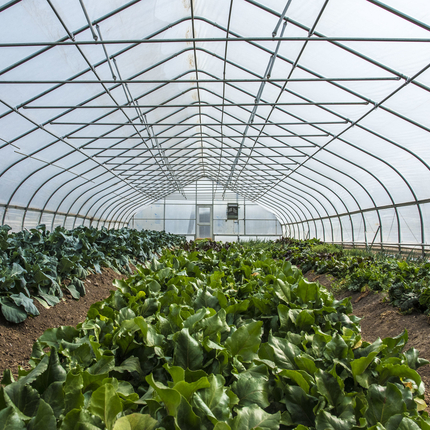The elements are one of the greatest adversaries for farmers. Changing temperatures and precipitation levels can limit growing seasons and affect the success of crops.
To help protect her crops from late frosts, storms, and high winds, Tanya Meyer-Dideriksen, a small-scale vegetable producer, installed a high tunnel on her farm in Oxford, Iowa. This has given her more control over her crop’s environment and lengthened the growing season.
Tanya, who also serves as state outreach coordinator for the U.S. Department of Agriculture’s Natural Resources Conservation Service (NRCS), has dedicated a great deal of her life to agriculture.
As state outreach coordinator, she helped start Women, Land, and Legacy, an education and outreach program, and works as the state tribal liaison and urban agriculture coordinator. When she is not spending her time educating and helping other farmers, she is growing her family’s 10-acre farm.
Her addition of a high tunnel has been one of her biggest projects on the farm. The Environmental Quality Incentives Program (EQIP) made the project affordable for her family, and they have learned a great deal throughout the process.
High tunnels bring greenhouses and in-ground farming together. Commonly referred to as hoop houses, they are built by attaching large hoops to grounded posts and covering the structure with durable plastic. The protective cover extends the growing season and reduces plants’ exposure to the elements. Unlike a greenhouse, all planting is done in the ground.
EQIP, administered by NRCS, provides financial assistance for producers who want to add basic high tunnels to their operations. Producers can add features, such as structure reinforcements, irrigation, and shade covers, which can be added to make the tunnels more versatile, but must do so at their own expense.
While Tanya works within NRCS, the process of applying for EQIP was new to her. Her local field office guided her through the process, helping her fill out the required forms and ensuring her paperwork was submitted by the deadline.
After her application was approved, she selected a high tunnel that met her needs. While professional set-up is an option, Tanya opted to install the high tunnel with the aid of her family to minimize her expenses.
Tanya says the high tunnel continues to be a learning experience. Since installing, she has learned the best timeframe for the extended growing season and the risks for a freeze if she starts too early. She’s also learned that planting a diverse set of crops within her high tunnel can help certain crops she has struggled with in the past.
As Tanya has learned, high tunnels can be an asset for many operations. Their versatility allows producers to find ways to make them successful on their farms.
Producers interested in adding high tunnels to their operation through EQIP can reach out to their local NRCS office to learn more.
Feature photo courtesy of the U.S. Department of Agriculture.





